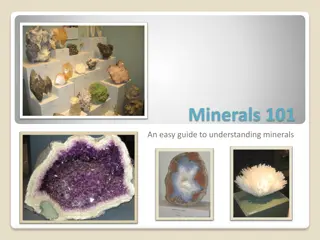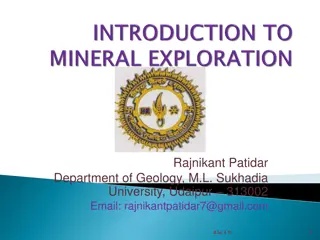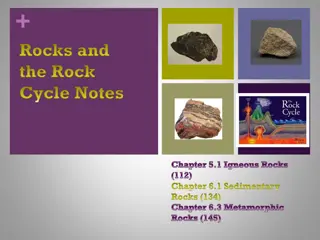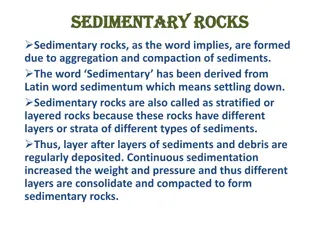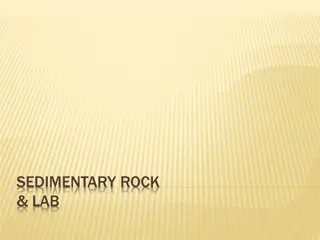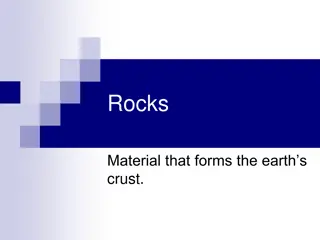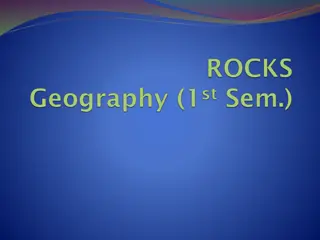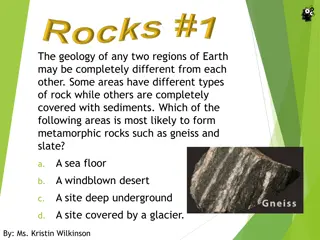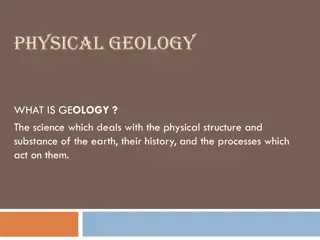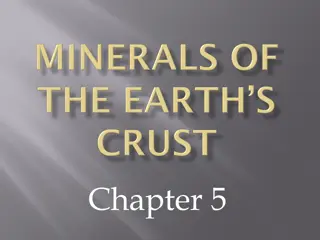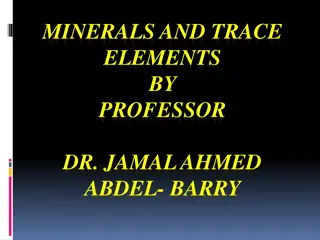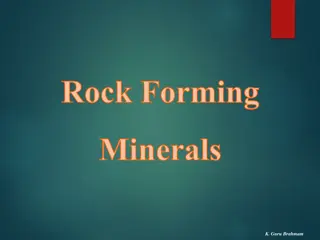Geology Test Review: Rocks and Minerals
This review covers the identification of rocks as igneous, sedimentary, or metamorphic, along with definitions and properties of minerals like cleavage, crystal structure, streak color, and more. It also discusses the classification of rocks as foliated or nonfoliated. Prepare for your geology test with this comprehensive study material.
Uploaded on Sep 11, 2024 | 2 Views
Download Presentation

Please find below an Image/Link to download the presentation.
The content on the website is provided AS IS for your information and personal use only. It may not be sold, licensed, or shared on other websites without obtaining consent from the author.If you encounter any issues during the download, it is possible that the publisher has removed the file from their server.
You are allowed to download the files provided on this website for personal or commercial use, subject to the condition that they are used lawfully. All files are the property of their respective owners.
The content on the website is provided AS IS for your information and personal use only. It may not be sold, licensed, or shared on other websites without obtaining consent from the author.
E N D
Presentation Transcript
Identify each rock as igneous, sedimentary, or metamorphic. pumice
Identify each rock as igneous, sedimentary, or metamorphic. pumice igneous
naturally occurring, inorganic solid that has a crystal structure and a definite chemical composition
mineral naturally occurring, inorganic solid that has a crystal structure and a definite chemical composition
property of minerals that break along smooth, flat surfaces
cleavage property of minerals that break along smooth, flat surfaces
orderly, repeating pattern in which the atoms in a crystal are arranged
crystal structure orderly, repeating pattern in which the atoms in a crystal are arranged
color of a mineral s powder
streak color of a mineral s powder
Which type of rocks are described as foliated or nonfoliated? igneous sedimentary metamorphic extrusive
Which type of rocks are described as foliated or nonfoliated? igneous sedimentary metamorphic extrusive
property of minerals that break along rough or irregular surfaces
fracture property of minerals that break along rough or irregular surfaces
process by which atoms form a solid with an orderly, repeating pattern
crystallization process by which atoms form a solid with an orderly, repeating pattern
way a mineral s surface reflects light
luster way a mineral s surface reflects light
A mineral is a naturally occurring (organic, inorganic) solid.
A mineral is a naturally occurring inorganic solid.
deposit of valuable metal containing minerals that can be produced at a profit
ore deposit of valuable metal containing minerals that can be produced at a profit
Identify each rock as igneous, sedimentary, or metamorphic. limestone
Identify each rock as igneous, sedimentary, or metamorphic. limestone sedimentary
grain size and arrangement of grains in a rock
texture grain size and arrangement of grains in a rock
texture naturally occurring solid mixture composed of minerals, smaller rock fragments, organic matter, or glass
naturally occurring solid mixture composed of minerals, smaller rock fragments, organic matter, or glass
rock naturally occurring solid mixture composed of minerals, smaller rock fragments, organic matter, or glass
process through which sediment turns into rock
lithification process through which sediment turns into rock
individual rock particle
grain individual rock particle
layered appearance of metamorphic rock that results from uneven pressures causing flat minerals to line up
layered appearance of metamorphic rock that results from uneven pressures causing flat minerals to line up
foliation layered appearance of metamorphic rock that results from uneven pressures causing flat minerals to line up
molten rock located within Earth
magma molten rock located within Earth
rock or mineral fragments that are loose or suspended in water
sediment rock or mineral fragments that are loose or suspended in water
What are the most abundant rocks on Earth?
igneous rocks What are the most abundant rocks on Earth?
process that moves large amounts of rock up to Earth s surface and to higher elevations
uplift process that moves large amounts of rock up to Earth s surface and to higher elevations
Identify each rock as igneous, sedimentary, or metamorphic. shale
Identify each rock as igneous, sedimentary, or metamorphic. shale sedimentary
process by which sedimentary rocks that are subjected to high temperatures and pressure transform into metamorphic rocks
metamorphism process by which sedimentary rocks that are subjected to high temperatures and pressure transform into metamorphic rocks
Identify each rock as igneous, sedimentary, or metamorphic. marble



